Renegade54 (talk | contribs) m (→Apocrypha appearances: copyedit) |
m (MA:CANON) Tag: sourceedit |
||
| (4 intermediate revisions by 2 users not shown) | |||
| Line 683: | Line 683: | ||
*{{NCwiki||''Constitution''-class}} |
*{{NCwiki||''Constitution''-class}} |
||
*{{wikipedia||''Constitution''-class}} |
*{{wikipedia||''Constitution''-class}} |
||
| − | *{{Forgotten Trek|designing-the-first-enterprise|Designing the First ''Enterprise''|external}} |
+ | *{{Forgotten Trek|designing-the-first-enterprise|Designing the First ''Enterprise''|external}} - article on Matt Jefferies' design of the ''Enterprise'' for ''The Original Series'' |
*{{Datalink|art/1701.html|Designing the Starship ''Enterprise''|external}} |
*{{Datalink|art/1701.html|Designing the Starship ''Enterprise''|external}} |
||
| − | *{{Forgotten Trek|designing-the-motion-picture-enterprise|Designing The Motion Picture ''Enterprise''|external}} |
+ | *{{Forgotten Trek|designing-the-motion-picture-enterprise|Designing The Motion Picture ''Enterprise''|external}} - article on the design of the refit ''Enterprise'' for ''The Motion Picture'' |
*{{Datalink|art/1701refit.html|Redesigning the ''Enterprise''|external}} |
*{{Datalink|art/1701refit.html|Redesigning the ''Enterprise''|external}} |
||
| − | *{{eas|articles/constitution-refit.htm|The ''Enterprise'' Refit of 2271|external}} |
+ | *{{eas|articles/constitution-refit.htm|The ''Enterprise'' Refit of 2271|external}} - analysis of the several modifications performed on the ''Constitution'' class |
*{{eas|articles/jefferies.htm|Where are the Jefferies Tubes?|external}} |
*{{eas|articles/jefferies.htm|Where are the Jefferies Tubes?|external}} |
||
Revision as of 06:15, 27 March 2015
AT: "xx"
The Constitution-class starships, which were also known as Starship-class1 or Class I Heavy Cruisers, were the premier front-line Starfleet vessels in the latter half of the 23rd century. They were designed for long duration missions with minimal outside support and are best known for their celebrated missions of galactic exploration and diplomacy which typically lasted up to five years.
History
In 2267, there were approximately twelve3 Constitution-class starships in the fleet. (TOS: "Tomorrow is Yesterday") These included the NCC-1700, the USS Constellation, the USS Defiant, the USS Enterprise, the USS Excalibur, the USS Exeter, the USS Hood, the USS Intrepid, USS Lexington, and the USS Potemkin.
The most famous Constitution-class starship was the USS Enterprise (NCC-1701), launched under the command of Captain Robert April in 2245. The Enterprise gained its reputation during its historic five year mission (2265-2270) under the command of Captain James T. Kirk. (VOY: "Q2")
In 2266, on stardate 1709, the Enterprise was instrumental in preventing a war between the Federation and the Romulan Star Empire. When a Romulan Bird-of-Prey crossed the Romulan Neutral Zone and destroyed several Earth Outpost Stations, Captain Kirk barely managed to outwit the enemy commander and stop his vessel from returning to Romulus and reporting on the Federation's weakness. (TOS: "Balance of Terror")
The mission parameters for the class meant that its vessels usually operated widely dispersed on their own and that encounters with class sisters were few and far between. However, the year 2267 saw a gathering of the class when a large part of its vessels was assembled at Starbase 11 for refitting and repairs. (TOS: "Court Martial")
Despite the successes of the class, exemplified by the performance of Kirk's ship, the mission parameters for the Constitution-class also meant that the vessels of the class operated under highly dangerous circumstances, resulting in a relatively high loss rate, and that being assigned to one was hazardous at best. In 2267 for example, the USS Constellation under the command of Commodore Matt Decker fell victim to what has become known as the "Doomsday machine", when it was on a routine survey mission near system L-374. Both ship and entire crew were lost. (TOS: "The Doomsday Machine") Likewise, and less than a year later in 2268, the Vulcan manned USS Intrepid was lost with its entire crew, in a fatal encounter with a huge simple cellular being in star system Gamma 7A of Sector 39J. (TOS: "The Immunity Syndrome") Later that year, the USS Exeter became infected with an unknown virus, a residue from biological warfare which had raged on Omega IV and which the ship was orbiting, again killing her entire crew, save for its captain, Ronald Tracey. While undamaged, the contaminated ship was for the time being left adrift. (TOS: "The Omega Glory")
In late-2268, Excalibur, Hood, Lexington, and Potemkin took part in the disastrous testing of the M-5 computer, which had been placed in control of the Enterprise. The Excalibur was severely damaged, with all hands lost. The Lexington also was brutally assaulted by the M-5 computer when the unit became unstable. (TOS: "The Ultimate Computer") Later that year, Defiant responded to a distress call from an unexplored sector of space, claimed by the Tholian Assembly. Shortly upon entering the region, the Defiant crew began experiencing sensory distortion, and insanity quickly spread throughout the ship. The ship's surgeon was unable to determine what was happening, and eventually the insanity induced by the phenomenon led the crew to kill each other.
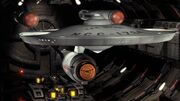
The Defiant in a Tholian drydock facility
Three weeks later, Starfleet ordered the Enterprise to mount a search mission to locate the Defiant. On stardate 5693.2, the Enterprise located her adrift, lost between universes in a space warp. As a result of a later phaser exchange between the Enterprise and several Tholian vessels, a hole was created through the spatial interphase, pushing the Defiant into the mirror universe. (TOS: "The Tholian Web")
Unknown to history in the "prime" universe, the Defiant emerged in the 22nd century mirror universe, where the Tholians of that universe had created the interphase rift by detonating a tricobalt warhead within the gravity well of a dead star. (ENT: "In a Mirror, Darkly") The Defiant would seemingly go on to play a major role in Empress Sato's rule over the Earth. (ENT: "In a Mirror, Darkly, Part II")
Physical arrangement
| File:Constitution class forward.jpg | 
|
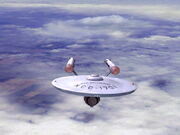
|
File:Enterprise impulse drive 2265.jpg |
The Constitution-class featured the saucer section-engineering section-warp nacelle layout common to most Starfleet vessels. All ships of the class of the same level of refit appeared to be identical at first glance, but closer inspection revealed minor detail differences on certain vessels. (TOS: "The Cage", "The Ultimate Computer"; Star Trek: The Motion Picture; etc.)
Various science labs, numbering fourteen in all, (TOS: "Operation -- Annihilate!") were located in the primary hull in the class' original configuration. An officer's lounge and dining area would be located in the aft superstructure beneath the bridge after the 2270s refit. (Star Trek: The Motion Picture) There were at least seven turbolifts that serviced the primary and secondary hulls. (TOS: "The Man Trap") The modular design of the Constitution-class allowed for component separation in times of crisis. The primary and secondary hulls could separate where the connecting "neck" joined the saucer, allowing either section to serve as a lifeboat if the other was too badly damaged. If an emergency was confined to the warp engine nacelles, it was theoretically possible to disengage and jettison them while keeping the bulk of the vessel intact. Any hull separation was considered a dangerous procedure and not always an option.(TOS: "The Apple", "The Savage Curtain")
Though not an aerodynamic craft, in emergencies, Constitution-class vessels were able to break orbit and enter a Class M planet's upper atmosphere (and maintain altitude control while passing through it) for a limited period of time, conditional on the ship's ability to re-achieve escape velocity. (TOS: "Tomorrow is Yesterday")
Refit history
USS Enterprise - early configuration bridge module in 2265
From 2254, or earlier, to 2265 Constitution-class vessels featured a large deflector dish, a large bridge dome of semi-spherical shape, and an antenna spike protruding from the Bussard collector cap on each warp nacelle. The impulse drive had two exhaust vents in 2254, and as many as eight smaller vents in 2265. (TOS: "The Cage", "Where No Man Has Gone Before")
Sometime between 2265 and 2266, the old deflector dish was replaced by a significantly smaller model, the spikes on the Bussard collectors were removed, a smaller bridge dome of flatter curvature was installed, the aft caps on the warp nacelles were each equipped with a spherical attachment, and the impulse drive now had only two large exhausts. (TOS: "The Corbomite Maneuver")
The interior passageways, main bridge interior and briefing room were already redesigned sometime between 2254 and 2265, and new intercoms were installed.
In 2266, the interior passageways were again modified, the briefing room was completely redesigned, and the overhauled main bridge featured an enlarged main viewscreen and upgrades to the control interfaces and station arrangement, but the overall appearance of the bridge remained relatively unchanged as compared to 2265. (TOS: "The Corbomite Maneuver")
The crew quarters of the 2254 configuration had the capability of carrying slightly more than 200 crewmembers. (TOS: "The Cage") In the 2266 configuration, crew quarters could hold a crew complement of over 400. (TOS: "Charlie X")
| File:Refit Constitution class forward.jpg | File:USS Enterprise refit, aft.jpg |

|
File:USS Enterprise-A refit, profile view.jpg |
In the late 2260s to early 2270s, the Constitution-class starships underwent their last known major refit program. The actual refitting took eighteen months of work and essentially a new vessel was built onto the bones of the old, replacing virtually every major system. Thus, the Constitution-class continued in service for at least a further twenty years.
Essential upgrades were made to the Constitution-class' warp systems; the old cylindrical nacelles were replaced with new angular ones and the warp nacelle struts were connected to the engineering hull much closer to the neck than before. The engineering hull roughly retained its original shape – while the original hull was essentially a conical cylinder, the refit was much more rounded.
The deflector dish was upgraded, doing away with the "satellite" dish architecture. As for the interior of the hull, the most obvious upgrades were the enlargement of the shuttle deck and landing bay, as well as the addition of a horizontal matter-antimatter reaction assembly and a vertical intermix chamber.
New also was the installment of the double photon torpedo launcher with its rectangular housing in the neck of the vessel. Also, the phaser configuration was changed to channel energy though the warp core. Furthermore, the saucer section was considerably extended (almost 20 meters), while the rest of the surface remained about the same.
Major changes were made to the interior of the Constitution-class starships; many new systems were added and existing ones upgraded. Summarizing, only the internal structure of the saucer and very little of the engineering hull and neck may have survived the 2270s refit. (Star Trek: The Motion Picture)
Some refit configurations had the warp nacelles rotated 90 degrees and included additional hatches along both sides of the saucer. (TNG: "Booby Trap")
Command and control systems
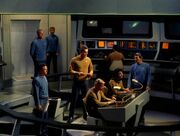
|
File:Constitution class bridge (2267).jpg |
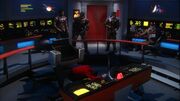
|
File:Constitution class bridge console.jpg |
The Constitution-class's primary command center, the main bridge, was located on top of the vessel's primary hull, on Deck 1. From here, the commanding officer supervised the entire starship's operation.
The command chair was located in the recessed area at the center of the room, in a direct line with the main viewer. This position was equidistant from all the control consoles that operated specific areas of the ship. Consequently, the captain could be immediately updated on the condition of the vessel or its crew during missions, and orders could be given clearly with a minimum of effort. The chair was mounted on a circular pillar, attached to a rectangular footplate that was directly anchored to the deck, giving it considerable support during an attack. It was designed to swivel on the support so that the captain could turn to any member of the bridge crew.
Piloting and navigation functions were carried out at the helm console, located in the center of the room, positioned in front of the command chair. This panel consisted of three main sections.
On the left was a compartment which opened automatically to permit operation of the targeting scanner. Next to this was the main control panel, which operated maneuvering thrusters, impulse engines, and fired the ship's weapons. Directly below this panel was a row of eight flip-switches provided to set warp flight speeds.
The central section of the conn panel was fitted with a number of sensor monitor lights, and was dominated by two main features: the alert indicator and the astrogator, which was used for long-range course plotting. The navigator's station had a control panel for entering course and heading data and the flight path indicator, and supplied information on any deviations or course corrections in progress. It also had controls for the weapons systems.
Other stations on the bridge were provided for communications, engineering, weapons control, gravity control, damage control, environmental engineering, science and library computer, and internal security. All stations were normally manned at all times.
Mounted into the room's forward bulkhead was the main viewscreen. Visual sensor pickups located at various points on the Constitution-class' outer hull were capable of image magnification and allowed a varied choice of viewing angles.
The computer systems aboard the Constitution-class starship were duotronic based. (TOS: "The Ultimate Computer"; DS9: "Trials and Tribble-ations")
Upgrades
| File:Enterprise bridge wide, TAS.jpg | File:Constitution class refit bridge 1.jpg |
| File:Constitution class refit bridge 2.jpg | File:Constitution class refit bridge, 2293.jpg |
Only one turbolift serviced the bridge of the original configuration Constitution-class ship. In the late 2260s, some were refit with a second lift on the port forward section of the bridge. (TAS: "Beyond the Farthest Star") After the major refit in the early 2270s, the bridge aboard Constitution-class vessels would continue to utilize two turbolifts, but both would be located behind the command chair. (Star Trek: The Motion Picture)
The bridge of the Constitution-class starships were subject to many minor and major cosmetic changes over their many years of service. In particular, the main bridge of the USS Enterprise seems to have undergone considerable changes in appearance. In the late 2260s, along with the added turbolift, the bridge design changed from a segmented flat-panel peripheral station configuration to a completely circular design, including curved overhead view screens, and railings and steps which matched the arc of the circumference. At the same time, an automatic bridge defense system was also installed that obscured the translucent overhead dome, which would not return until the Galaxy class bridge. (TAS: "Beyond the Farthest Star") This marked the beginning of major changes to come which would utilize the updated substructure, most notably, its systems were fully upgraded along with the refit of the early 2270s. (Star Trek: The Motion Picture)
The bridge underwent only a few minor modifications from that point until the destruction of the ship in 2285. The bridge of the USS Enterprise-A, commissioned one year later (in 2286), had mainly cosmetic differences at launch, but, by 2287, it had been drastically upgraded to reflect the advances made in computer control technology. The bridge module had again been replaced by 2293. The lighter color scheme of the original Enterprise-A bridges had made room for a darker, more militaristic look. (Star Trek II: The Wrath of Khan; Star Trek IV: The Voyage Home; Star Trek V: The Final Frontier; Star Trek VI: The Undiscovered Country)
Propulsion systems
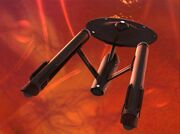
Aft view of an original configuration vessel
The Constitution-class of starships has been fitted with both lithium and dilithium reactor circuits in the warp drive assembly over its service lifetime. The vessel's standard cruising speed was warp 6, while its maximum cruising speed was warp 8. Warp 9 was also possible for this class of starship, although it was highly discouraged because it was an unsafe velocity.
The USS Enterprise was twice modified to achieve a speed of warp 11. The probe Nomad increased the ship's engine efficiency by 57% in 2267, allowing the ship to reach warp 11, but Kirk persuaded Nomad to reverse its "repairs" because the ship's structure could not stand the stress of that much power, and would eventually destroy the ship. (TOS: "The Changeling")
More extensive modifications made to the ship by the Kelvans in 2268, who were able to produce velocities that were far beyond the reach of Federation science, allowing the Enterprise to safely maintain a cruising speed of warp 11 while traveling through the intergalactic void. (TOS: "By Any Other Name")
The maximum warp speed recorded for this class by itself was warp 14.1, achieved by the Enterprise due to sabotage to the vessel's warp drive system. While the ship itself was not structured to take that speed for any length of time, the Enterprise was able to maintain that velocity for nearly 15 minutes. (TOS: "That Which Survives")
A close-up of the refit configuration impulse drive
The Enterprise also maintained stability at warp 22, while tractored to a ship going warp 32. (TAS: "The Counter-Clock Incident")
Following the 2270s refit of the class, the Constitution was equipped with a linear dilithium-controlled MARA (Matter/Antimatter Reactor Assembly), and a pulse dilithium-controlled assembly was installed by the mid 2290s aboard the USS Enterprise. (Star Trek II: The Wrath of Khan; Star Trek VI: The Undiscovered Country)
The Constitution-class' impulse drive system was a twin-port engine, capable of velocities at least warp factor 0.8. (Star Trek: The Motion Picture) A fusion explosion equivalent to at least 97.835 megatons would result if the impulse engines were overloaded. (TOS: "The Doomsday Machine")
Main engineering
| File:Constitution original engineering2.jpg | File:Constitution original engineering.jpg |
| File:Warp core TAS.jpg | File:Main engineering, dilithium chamber.jpg |
| File:Constitution class refit engineering.jpg | File:Constitution Engineering.jpg |
Main engineering was from where the ship's warp was controlled. All thrust and power systems were primarily controlled from this site, and it is also where the main dilithium crystal reactor was located. Life support was controlled separately from Deck 6. (TOS: "The Ultimate Computer", "The Corbomite Maneuver", "The Naked Time", "The Enemy Within", "The Conscience of the King", "Day of the Dove")
During the 2270s Constitution-class refit, the interior design of the engineering section was drastically upgraded, featuring the vertical warp core and the horizontal intermix area.
Main engineering was lodged on Decks 14 and 15. Deck 14 was the uppermost level of the engineering hull, and was the anchoring framework for the connecting dorsal and the warp nacelle pylons.
On the forward end of the deck was the engineering computer monitoring room, which encircled the cortical intermix shaft and opens, to the rear, into the engineering computer bay.
Deck 15 housed the main engineering room. Located in the center of the room, and extending for many levels both above and below the deck, was the vertical linear intermix chamber. This complex, radically new design in intermix technology, provided operational power for the impulse drive system and furnished enough additional energy to power all other shipboard systems.
Both matter and antimatter for this chamber were contained in a series of magnetic bottles, which were housed in pods at the base of the intermix shaft. (Star Trek: The Motion Picture)
Tactical systems
Laser and phaser systems

Forward phasers of the USS Enterprise
During the early 2250s, Constitution-class heavy cruisers were armed with a complement of directed energy weapons, that possessed enough power to destroy half a continent in a concentrated bombardment. In addition, these vessels carried on board laser cannons, capable of operating on energy fed remotely from the ship. (TOS: "The Cage", "The Menagerie, Part I", "The Menagerie, Part II")
By 2266, phaser banks were standard complement aboard this class of ship. A bank actually consisted of a single emitter and its power supply, though it was common practice to fire two banks at a time and refer to it as a single firing. (TOS: "The Corbomite Maneuver", "The Doomsday Machine", "The Paradise Syndrome")
Ship-mounted phaser banks had a range of approximately 90,000 kilometers. Like hand phasers, they were capable of being adjusted to stun, heat, or disintegrate targets, including objects or beings in space or on a planets surface. The focus could be adjusted from a narrow to a wide beam. When only motion sensor readings were available, the ships phasers could be set for proximity blast and bracket the approximate coordinates of the target. (TOS: "Balance of Terror", "A Piece of the Action", "Who Mourns for Adonais?", "The Paradise Syndrome", "The Tholian Web")
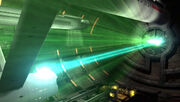
Original configuration Constitution-class USS Defiant firing its secondary hull aft phasers
In the original configuration, a battery of several forward phaser emitters was located on the lower part of the ventral side of the saucer section. Aft firing banks were located above the shuttlebay on the secondary hull. There were also port, starboard and midship phasers. (ENT: "In a Mirror, Darkly, Part II"; TOS: "Balance of Terror", "The Paradise Syndrome", "Arena", "Friday's Child").
A refit Constitution vessel fires its forward phasers
After the refit of the 2270s, Constitution-class ships mounted three dual-emitter phaser banks on the ventral and three on dorsal faces of the saucer. They covered the forward, port and starboard flanks. Two single emitter aft banks are above the shuttlebay and four midship single emitter banks were located on the ventral surface of the engineering hull. Phaser power was increased by drawing energy directly from the warp drive. This increase in firepower had a drawback in that the phasers would be cut off if the main reactor was off line. This problem hampered the USS Enterprise on at least two occasions, one in the 2270s and again in 2285. (Star Trek: The Motion Picture; Star Trek II: The Wrath of Khan)
Torpedo systems
Torpedo launcher (original configuration)
The Constitution-class originally mounted six forward torpedo tubes and an aft tube for launching photon torpedoes. The forward tubes were located in the same area as the forward phaser banks. The tube covering the aft firing arc launched torpedoes from the end of the secondary hull. This combined arsenal was powerful enough to destroy the entire surface of a planet. (TOS: "Arena", "A Taste of Armageddon", "Journey to Babel"; TAS: "More Tribbles, More Troubles"; ENT: "In a Mirror, Darkly, Part II")
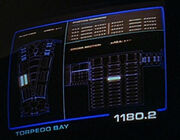
Torpedo manifest (refit configuration)
Torpedo launcher (refit configuration)
The post-refit vessels had two forward firing torpedo launchers, though each tube could fire at least two torpedoes before reloading. (Star Trek II: The Wrath of Khan; Star Trek III: The Search for Spock)
Deflector shields
Deflector status display
The Constitution-class starship had a powerful deflector shield grid in the 2260s. The shield grid was divided into four segments, referred to as "number one shield", "number two shield", etc. (TOS: "Journey to Babel", "Elaan of Troyius") At full power, with the warp reactor tied into the shield system, it was capable of absorbing and repulsing a bombardment of energy impacts equal to the detonation of 360 photon torpedoes of the type the Enterprise was equipped with at the time, before the shielding power was completely lost. In 2267, for example, the Enterprise survived an attack from the Nomad probe. Nomad fired four powerful bolts of energy, each with the equivalent force of 90 photon torpedoes. The first hit reduced shielding power only by twenty percent. After being hit with the equal force of 270 photon torpedoes, warp maneuvering power was lost. Shields were lost with the fourth hit. (TOS: "The Changeling")
The deflector shield grid was much more vulnerable to intense standard phaser bombardment. In 2268, an Orion scout ship was able to cause buckling in some of the shields of the Enterprise after it had made just five attack runs on the ship. On the seventh run, the Enterprise lost one of its four shields. (TOS: "Journey to Babel") Other more powerful weaponry could take the shields down even more easily, the planet killer for example could completely deplete a Constitution-class starship's shielding power with only three hits with its antiproton beam. (TOS: "The Doomsday Machine")
The diversion of all but emergency maintenance power to the shields had the adverse affect of reducing phaser power by fifty percent. (TOS: "The Tholian Web") A single detonation of a nuclear warhead less than a hundred meters away could cause internal overloads on the ship and leak radiation through the shields to the outer regions of the ship. (TOS: "Balance of Terror") Without the warp reactor to power the shields, the system was not very effective in protecting the ship. With only the impulse reactors powering the shields, a D7 class Klingon battle cruiser could deplete a Constitution-class starships shielding power with only few passes of disruptor fire. (TOS: "Elaan of Troyius")
After the refit, in the 2280s, a Constitution-class starships needed 13.5 seconds to lower and raise their shields when taking a shuttlecraft on board via its tractor beam. Flying the shuttle in manually reduced this time significantly. (Star Trek V: The Final Frontier) During yellow alerts, defense fields were activated to offer basic protection to the main bridge. (Star Trek II: The Wrath of Khan)
Transporter systems
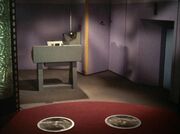
|
File:Constitution original transporter.jpg |
| File:Constitution transporter.jpg | File:Constitution class refit transporter.jpg |
Extravehicular transporter to and from the ship was accomplished by a number of transporter systems, which allowed personnel or equipment to be transported over large ranges. The transporter platform featured six pads, which were numbered clockwise, beginning with the right front. A redesigned field generator matrix was mounted into the rear wall of the chamber aboard the refit configuration Constitution-class starships.
Aboard the refitted Constitution-class vessels, the transporter operator stood within an enclosed control pod, which had a floor-to-ceiling transparent aluminum panel through which he or she could view the transport platform. This panel served to shield the operator from the effects of any cumulative radiations emitted by the new transporter machinery, a side effect of the more powerful system.
A door in the standard transporter room wall led to a staging area where landing parties prepared for transporter.
Airlocks
Airlock staging area in the 2270s
Refit Constitution-class starships possessed a number of airlocks permitting direct physical access to the ship. One was located at the aft of Deck 1 on top of the saucer section. Two more were located in the lower saucer section, port and starboard, concealed by sliding hull plates. (Star Trek: The Motion Picture)
These lower two are accessed through staging areas. Four spacesuit lockers line one wall; each containing one suit, providing enough to clothe a standard party of four. A small, locked arms cabinet held phasers; communicators, tricorders, translators, and outerwear were contained in a separate cabinet on another wall. (Star Trek: The Motion Picture)
The next set of airlocks were located on the port and starboard sides of the torpedo bays. The final set were located on the port and starboard sides of the secondary hull at the midline. (Star Trek: The Motion Picture; Star Trek II: The Wrath of Khan) These airlocks opened into the ship's main cargo bay. There was also a "gangway"-style airlock on the port edge of the saucer section. (Star Trek: The Motion Picture)
Located on the upper surface of the saucer section of the refitted Enterprise were numerous small hatches used for entrance/egress during extra-vehicular activities. (Kirk, Spock, Decker, McCoy, and the Ilia probe use one of these hatches to leave the ship when they arrive at V'Ger's "core".) (Star Trek: The Motion Picture)
Landing bay and cargo facilities

|
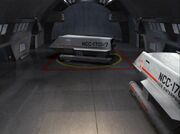
|
| File:Constitution class refit landingbay.jpg | File:Enterprise-A shuttlebay.jpg |
Deck 17 was the main access level of the engineering hull. The aft landing bay provided personnel in small craft with a means of entering or exiting the vessel, as did docking port on either side of the level.
The original configuration of the Constitution-class carried a standard complement of 4 shuttlecraft, some of which were Class F. (TOS: "The Omega Glory")
The refit configuration Constitution-class starship featured a new landing bay design. A wide range of Starfleet and Federation craft could utilize this state-of-the-art landing facility. Alcoves on either side of the landing bay provided storage for up to six standard Work Bees, and furnished all necessary recharging and refueling equipment. Additional space was available for the storage of non-ship shuttlecraft.
Just within the landing bay doors was a force field generator unit, which was built into the main bulkheads on either side of the entry area. This field allowed craft to enter the ship, while at the same time retaining the atmosphere and temperature within the landing bay.
Deck 18, the refit configuration shuttlecraft hanger bay, was situated at the widest point of the engineering hull. Much of the deck consisted of open space, as it was the mid-level of the cargo facility; thirty-two cargo pod modules could be stored in the alcoves lining the forward, port, and starboard sides of the bay.
The shuttle hangar had sufficient room for the storage of four craft at any given time. During normal storage situations, these shuttlecraft faced aft.
This deck also housed the vessel's lifeboat facilities. These one-man craft, which escaped through blow-away panels in the side of the secondary hull, were provided for those persons were unable to reach the primary hull in case of an emergency. (Star Trek: The Motion Picture)
Crew support systems
Medical systems
Biobeds in sickbay
On the original Constitution-class starships, a sickbay facility was located on Deck 6, which featured an examination room, a nursery, the chief medical officer's office and a medical lab. At least one other medical lab was located elsewhere on the vessel, and was used for biopsy, among other things. Sickbay was considered the safest place to be on the ship during combat. (TOS: "The Naked Time", "Elaan of Troyius")
Intensive Care Unit on a refit configuration vessel
Refit configuration examination room
With the class refit of the 2270s, the medical facilities of the Constitution-class starship were considerably updated. New micro-diagnostic tables were capable of fully analyzing the humanoid body at the sub-cellular level, offering the physician a total understanding of the patient's status.
Another new addition was a medical stasis unit, in which patients whose conditions were considered immediately life-threatening could be placed into suspended animation until the proper cure or surgical procedure could be established. (Star Trek: The Motion Picture)
Crew quarters
Crew quarters in the 2260s
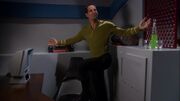
Senior officers's quarters on an original Constitution
Officers's quarters on a refit configuration Constitution
Crew quarters were located throughout the saucer section – keeping with Starfleet tradition, Deck 5 housed the senior officers' quarters. On the refit configuration vessels, these staterooms were quite similar to the VIP units on Deck 4, with only a few differences.
On starships of the original configuration, the officers' quarters featured two areas, separated partly by a wall fragment. One area was allocated as sleeping area, featuring a comfortable bed, and another as work area, including a desk and computer terminal. Entrance to a bathroom was provided through the quarter's sleeping area. Both areas could be configured to personal preference. (ENT: "In a Mirror, Darkly, Part II"; TOS: "The Enemy Within")
On Constitution-class vessels, staterooms of the senior officers were composed of two areas which were separated by a retractable, transparent aluminum partition. The room's entrance opened into the living area. A library computer terminal and work desk were provided here. The room's corner circular nook, normally occupied by a dining booth, could be modified at the officer's request.
The other half of the stateroom was a sleeping area, which held a single large bed that could double as sofa during off-duty relaxation. A transparent door led into the bathroom area. By the 2290s, crew space was at a premium, and the size of officers' quarters was reduced to one large room and crewmen were housed in dormitories with bunk beds. (Star Trek: The Motion Picture; Star Trek VI: The Undiscovered Country)
Recreational facilities
A typical recreation room (2260s)
Recreation room (refit configuration, 2270s)
Aboard the original Constitution-class starships, there were at least six recreation rooms, which included three-dimensional chess and card game tables. There was also a holographic rec room, which was the predecessor of the holodeck. Also aboard were as arboretum, gymnasium, a bowling alley, a theater, and a chapel. (TOS: "Charlie X", "The Naked Time", "The Conscience of the King"; Star Trek: The Motion Picture)
On the refitted Constitution-class vessels, recreational facilities were further expanded. One large room in the aft section of the starship's saucer section furnished off-duty personnel with a wide variety of recreational games and entertainment. At the front of the room was an immense, wall-mounted viewing screen. Beneath this was an information display alcove; five small screens exhibited, upon request, a choice of pictorial histories. A raised platform in the center of the lower level floor featured a diversity of electronic entertainment. (Star Trek: The Motion Picture)
Officers' lounge
Officers' lounge privacy area on a Constitution-class vessel of the refit lineage
Located at the stern of Deck 2 aboard the refit configuration Constitution-class starship was the officers' lounge. Here, four huge view ports afforded a spectacular view of the ship's warp nacelles and space beyond.
To the sides, small plant areas held flora from several worlds and a small pool featured freshwater tropical fish. Just forward of this section of the lounge were two privacy areas. In each privacy area, a view screen was mounted into the wall, providing a full exterior tour of the vessel. (Star Trek: The Motion Picture)
Ships commissioned
|
|
Appendices
See also
Appearances
The Constitution-class Enterprise appeared in every episode of TOS and TAS (except for "The Slaver Weapon"). TOS episodes featuring other Constitution-class vessels besides Enterprise are listed below.
- TOS:
- "Court Martial" (remastered version only)
- "The Doomsday Machine"
- "The Ultimate Computer"
- "The Omega Glory"
- "The Tholian Web"
- Star Trek films:
- Star Trek: The Motion Picture
- Star Trek II: The Wrath of Khan
- Star Trek III: The Search for Spock
- Star Trek IV: The Voyage Home (original and refit)
- Star Trek V: The Final Frontier
- Star Trek VI: The Undiscovered Country
- Star Trek Generations (painting)
- Star Trek: First Contact (model)
- Star Trek Nemesis (model)
- TNG:
- "The Naked Now" (graphic display, refit)
- "Lonely Among Us" (model)
- "The Battle" (model)
- "Hide and Q" (model)
- "Haven" (model)
- "The Big Goodbye" (model)
- "The Bonding" (model)
- "Booby Trap" (model)
- "The Best of Both Worlds, Part II" (wreckage)
- "The First Duty" (model, original)
- "Relics"(bridge)
- DS9:
- "Homefront" (model)
- "Paradise Lost" (model)
- "Trials and Tribble-ations"
- "What You Leave Behind" (corridor in montage scene)
- VOY: "In the Flesh" (wall display, original and refit)
- ENT:
Background information
For information on the origin of the Constitution-class designation, please see: Footnote 1
Interiors
For information on the Constitution-class interior sets, please see: Constitution class sets
Registry number
Art Director Matt Jefferies was, apart from designing the ship, also responsible for conceiving its original, famous registry number "NCC-1701". As he explained, "Since the 1920's, N has indicated the United States in Navy terms, and C means 'commercial' vessel. I added an extra C just for fun. Interestingly, Russia's designation is CCC. So The N and C together made it kind of international. After that, I had to pick some numbers. They had to be easily identifiable from a distance, so that eliminated 3, 8 , 6, 9 and 4-none of which is that clear from a distance, That didn't leave much! So 1701 was as good a choice as any. The reason we gave for the choice afterwards was that the "Enterprise" was the 17th major design of the Federation, and the first in the series. 17-01!" (Star Trek: The Original Series Sketchbook, p. 62), "(...)which, incidentally and coincidentally, happens to be very close to the license number on my airplane-NC-17740. But I have never really stepped out and squashed the rumor that the number on the "Enterprise" came off my airplane." (Star Trek: The Magazine Volume 1, Issue 10, p. 26)
Saucer separation
A saucer separation capability for the Constitution-class was suggested as early as the second season of the Original Series in the original script of its episode "The Apple", but was never produced for budgeting reasons. The capability was however envisioned by the producers, "Designed to operate separately from the rest of the ship, the saucer therefore contains all elements necessary for independent operation." (The Making of Star Trek, p. 171) The intent made it even into the official series' internal writer's guide, The Star Trek Guide (third revision, page 15 of the supplement and generally dubbed the "Writer's Bible"), where the saucer section was described to be "in fact a completely self-sustaining unit which can detach itself from the galaxy drive units and operate on atomic impulse power for short range solar system exploration." [1]
The original saucer separation intent was reconfirmed years later on two occasions, when efforts were underway to revitalize the live-action franchise. Production Illustrator for Star Trek: Planet of Titans, Ralph McQuarrie, stated on several of the concept drawings he had created for a newly conceived Enterprise, "The saucer of the Enterprise (which was detachable) ends up in the shroud. They meet the aliens and had a dramatic finale. These two images are of the Enterprise saucer in the shroud.(...)The disc of the Enterprise would separate from the rest of the ship to land on the surface of planets." [2] The sketches, McQuarrie referred to, of the independently operating saucer section, were published in The Art of Ralph McQuarrie (pp. 124-129). The second occasion occurred when Star Trek: Phase II Producer Robert Goodwin reported in a progress memo dated 8 September 1977, "Meanwhile we're having a new model of the Enterprise constructed, with the added bonus of a saucer section which can separate from the engine nacelles, should such a maneuver be a necessary part of some story. This capacity of the Enterprise was described in The Making of Star Trek, although it was never utilized in the first series." (Starlog, issue 11, p. 39)

TMP saucer separation concept

TMP saucer separation concept
Yet another saucer separation sequence was envisioned by Andrew Probert in 1979 when script treatments for Phase II's successor, The Motion Picture, were in flux. During a lull in script development Probert came up with an alternative scene in which V'Ger releases a Klingon K't'inga-class battle cruiser. Upon re-materialization the Klingons true to their nature immediately attack the Enterprise. During the battle Kirk is forced to a perform a maneuver akin to that of William T. Riker in "The Best of Both Worlds, Part II". Douglas Trumbull liked the idea and had Probert draw up color story-boards to show the sequence. Some of the story-boards were published in Star Trek: The Magazine Volume 1, Issue 22, p. 132, and in The Art of Star Trek, pages 198-199. Probert's concept was not entirely a flight of fancy as the actual studio model, in line with Goodwin's prior memo annotation, was constructed in such a way that a saucer separation could be filmed if the need arose. (Star Trek: The Next Generation Companion, 3rd ed., page 9) Probert himself remarked in this regard, "The Enterprise was always designed to separate from the Engineering section. I knew about this when I did Star Trek: The Motion Picture. And if you look at the bottom of Kirk's Enterprise [note: original configuration], you'll notice two triangular items, which are two of the landing feet for the saucer. Regardless of whether it was Matt Jefferies' original intention or not, it's sort of the way that "Trekdom" or "Star Trek lore" has labeled those features. So taking my cue from that for Star Trek: The Motion Picture, I placed four landing legs in the bottom of the Enterprise and crated a very specific separation line on the dorsal." (Star Trek: The Next Generation USS Enterprise NCC-1701-D Blueprints, booklet, p. 8)
Size
| File:Constitution-class USS Enterprise NCC-1701 finalized plan views by Matt Jefferies.jpg | |
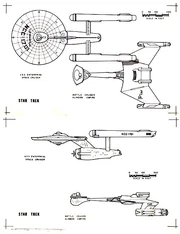
|
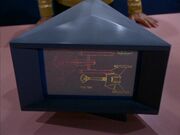 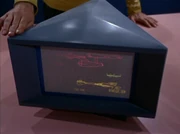
|
The dimensions of the Constitution-class, being 947 feet (289 meters) long for the original configuration and 1000 feet (305 meters) for the refit-configuration, have been set in stone in time immemorial as far as Star Trek -lore is concerned. That being said and oddly enough, neither dimension has actually ever been canonically confirmed, as neither dimension was ever seen or referred to in any of the live-action Star Trek productions.
The original configuration length of 947 feet was first derived from Stephen Edward Poe's reference book, The Making of Star Trek, p. 178, and that dimension has been propagated in every subsequent reference work ever since. However, what Poe did not mention was that designer Matt Jefferies had originally produced that graphic in 1967 as a reference for Poe's employer, model kit company Aluminum Metal Toys for their 1968 second edition retooled USS Enterprise model kit, no. S951 – where the graphic was displayed on the side of the box prior to its publication in the book – and not for the actual Original Series production. Remarkably, the dimension of the starship had been in flux until that time as a Producer Gene Roddenberry's memo of 24 August 1964 evidenced, "We anticipate a final design might see the ship as 200 feet in length, and thus even a 1½-inch scale would give us quite a huge miniature." This figure, initially accompanied with a crew complement of 203 would actually more or less stand until Jefferies, utilizing his engineering background, recalculated the figures for his design three years later. (The Making of Star Trek, pp. 89, 134)
The original configuration Constitution-class length came closest to canon, when two ship size comparison graphics were featured in the Original Series third season episode "The Enterprise Incident". The two computer console graphics, also created by Jefferies, showed a Constitution-class vessel in comparison with a Romulan D7-class battle cruiser and an in the episode barely discernible yardstick. Yet, careful measurement of the production art of the graphic, using the featured yardstick, measured the Constitution-class vessel actually at exactly 900 feet (274 meter). Jefferies later sold his original plan view design art, including that for AMT, in the Profiles in History The Star Trek Auction of 12 December 2001, in order to raise funding for the "Motion Picture & Television Fund" charity.
Likewise, the 1,000 feet length of the refit-Constitution-class was never canonically established on screen either, instead generally gleaned from the 1991 reference book, Star Trek: The Next Generation Technical Manual, where it was propagated to the public at large. The Manual itself was based on the internal document Star Trek: The Next Generation Writers' Technical Manual in which Andrew Probert had provided dimensions for most of the more prominent Starfleet vessels until then established in the live-action franchise. Actually, Probert himself had in turn based his dimensions on the size comparison production art, Visual Effects Art Director Nilo Rodis had created for Star Trek III: The Search for Spock, published in a Cinefantastique article (Vol 17 #3/4, 1987, p. 77) almost half a decade earlier, and where the size was in fact already disclosed for the very first time. This was not a whimsical act on Rodis' part; As that movie introduced a multitude of newly designed starships at once and since studio models were almost never build in scale to each other, visual effects compositors at Industrial Light & Magic needed some sort of a reference dimensional framework in order for them to take the ships' relative sizes into account, when editing their ship effects footage if more that one appeared in a shot, for the interior Earth Spacedock scenes in particular. By setting the refit-Enterprise at exactly 1,000 feet, Rodis used that ship as the yardstick against which all other ships were measured in the movie.
Studio models
For information on the Constitution-class studio models, please see:
- Constitution-class model (original)
- Constitution-class model (refit)
Footnotes
| File:Constitution primary phaser.jpg | 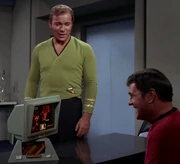
|
| File:Chief engineer Montgomery Scott examining a Constitution class diagram.jpg | |
1 "Starship-class": If one read the dedication plaque on the bridge of the original Enterprise, it was actually listed as "Starship Class". The term "Constitution-class" originated from the script for the season one episode "Space Seed". Scenes 44 and 48 of the Second Revised Final Draft for "Space Seed," dated December 13, 1966 had the following content:
- 44 ANGLE ON SICK BAY VIEWER
- It is covered with mathematical symbols and diagrams. CAMERA PULLS BACK to show Khan studying with great concentration. He pushes a button. Another transparency appears: a chapter heading, reading: BASIC SPECIFICATIONS, CONSTITUTION CLASS STAR SHIP.
and,
- 48 INSERT - SCREEN
- A chapter heading: Basic Propulsion Systems, Constitution Class Star Ship.
That the scripted screen indicators indeed pertained to Kirk's ship followed from the prior conversation:
- "I was once an engineer of sorts. I would be most interested in studying the tech manual on your vessel. After all, I have two hundred years of catching up to do."
- "They are available on your viewing screen there. Dr. McCoy will show you how to hook into our library tapes."
- - Khan and Kirk, in the sickbay of the Enterprise
The graphic that was constructed for this script direction, but which was ultimately not used in the episode according to the influential "The Case of Jonathan Doe Starship" article by Greg Jein, published in the April 1973 issue 27 of the T-Negative fanzine, did make its first canon appearance in the second season episode "The Trouble with Tribbles", as an otherwise unreadable graphic of a technical journal on a computer screen that Scotty was reading, showing a phaser bank diagram for a "Constitution-class" starship. The graphic was actually created by Art Director Matt Jefferies, who used his own extensive aviation library as his source. Depicted were two varieties of hydraulic fluid reservoirs, used by the US Air Force at the time. [3] The graphic was endowed with a caption, gleaned by Jein for his article after he had obtained a trimmed clipping from Lincoln Enterprises showing the graphic in its entirety, that read,
- PRIMARY PHASER L, R
- STAR SHIP MK IX/01
- CONSTITUTION CLASS
While this scripted reference was "understood" to have established the Enterprise belonging to the Constitution-class ever since by production staffers and fans alike, it was not until 1982 that the designation started to seep into canon. Authors of reference works such as Franz Joseph's Star Fleet Technical Manual were privy to scripts' contents, and to the fact that Enterprise herself was Constitution-class, even though it had never been mentioned in dialog or been readable on screen. Drawings from the aforementioned Technical Manual with the class name appeared on screen, again unreadable, in The Wrath of Khan and The Search for Spock. These were the first occasions a canonical production assigned the Constitution name to the class designation of the Enterprise. The Voyage Home assigned this class name to the refit-Enterprise as well, although some production staff previously and, apparently, unofficially called that design Enterprise-class, which actually was utilized, and discernible, for the Mark IV bridge simulator seen in The Wrath of Khan. The name Enterprise-class was also used in reference to the refitted Enterprise and the Enterprise-A in Mr. Scott's Guide to the Enterprise, though that particular reference book is neither considered canon nor "official". (Star Trek: The Magazine Volume 2, Issue 11, p. 71)
The first time it was actually referred to as such in dialog, was by Captain Jean-Luc Picard in the first season episode "The Naked Now" of Star Trek: The Next Generation, which was followed by the first firm visual, clearly legible, confirmation in the form of the heading of a blueprint Scotty was examining in The Undiscovered Country, firmly establishing the fact in canon and concurrently dispelling any Enterprise-class notion definitively, as this blueprint also clearly noted his ship as a Constitution-class vessel. The designation has been mentioned several times and been more prominently visible in later series and episodes referencing ships of the Original Series and movies design. In the Star Trek: Enterprise episode "In a Mirror, Darkly" the dedication plaque of the USS Defiant (NCC-1764) clearly stated that she belonged to the Constitution-class (In the original third season episode "The Tholian Web", the plaque, which was of course Enterprise's, could not be seen due to deliberate camera angles). Not being one of the ships listed in the original final names list as reproduced in The Making of Star Trek (p. 165), used by the production team of the series, and although not being canon, this strongly suggested two things according to Greg Jein; Firstly, Starfleet changed its nomenclature from Starship-class to Constitution-class during the run of the Original Series-era (nicely tying in with Scotty keeping abreast by reading technical updates for the ship he is working on), and secondly, the Defiant belonged to a later batch of Constitutions (supported by the fact she has the highest registry number of all the definitively established Constitutions). Commissioned somewhere during the Original Series-era, she therefore had an unfortunately short career, at least in Star Trek's prime universe, or as Jein had succinctly put it, "Tough break". [4]
2 The launch date of the class has never been established, but the reference book The Making of Star Trek stated on page 203 that the producer's intent was that the "Enterprise-class starships have been in existence for about forty years." Its author Stephen Whitfield, who had full access to production sources, wrote the book during the production of season two, narrowing the class launch window down to the mid-2220s. Interestingly, this meant that the Enterprise was a relative latecomer into the class, as its launch year was generally understood, but not firmly established, to be 2245 by production staffers and as was propagated in numerous reference books afterwards. Greg Jein in his article also proceeded from this understanding, and taking his cue from the "MK IX/01" annotation in the aforementioned technical journal graphic, postulated the ship to be of a newer "MK IX" subclass, with the USS Constitution (NCC-1700) as its (sub-)class vessel, in the process trying to make sense of the lower registry numbers by postulating them to belong to older sub-classes. Jein postulated the Enterprise as the second MK IX subclass member, hence the justification of the "01" addition to both the registry "NCC-17" and the technical journal graphic as seen, the reasoning adopted by the original registry designer, Matt Jefferies, as he himself had stated above. [5]
3 There may only be twelve Constitution-class ships as of the first season episode "Tomorrow is Yesterday", but the line this was drawn from ("there are only twelve like it in the fleet") has given rise to speculation that the Enterprise should be excluded from the count, meaning there could be thirteen Constitution-class ships as of that date. The twelve ship assertion was actually supported by production sources, as The Making of Star Trek (pp. 163, 203) clearly stated that, as far as the production staff was concerned, the intent was that there were twelve operational ships of the class foreseen for the second season by the time of its production, the Enterprise included and taking into account the two ships, USS Valiant and USS Farragut, already established as being destroyed in the first season episode "A Taste of Armageddon", and already foreseen as mentioned destroyed in the second season episode "Obsession", respectively. Kirk's statement then neatly corresponded with the twelve ship assumption; two, the Farragut and Valiant, presumed destroyed before the remark, with the USS Constellation (in "The Doomsday Machine", and already accounted for by D.C. Fontana in her memo version, though it was still in operation at the time of "Tomorrow is Yesterday" canonically) and USS Intrepid (in "The Immunity Syndrome") being destroyed after the remark. It should be noted that the inclusion of the Valiant was a late addition and that it was not even considered in the first two proposals. This, canonically speaking at least, constituted somewhat of a conundrum, an observation not lost on Greg Jein, as he had noted that the ship in question was already destroyed in 2217, whereas the Constitutions only became operational a decade later as far as was established by the producers. [6] While another, new ship would have made more sense, the intent of the producers was clear, the class was retro-applied to the lost ship. Yet, the twelve ship statement only held true under the supposition that the Defiant – not foreseen by the producers – had not yet been commissioned, which is open to debate; otherwise, and this was implied by the fact that the ship was already fully operational less than a year later, the thirteen ship number became valid.
After some corresponding with suggestions to and fro, the definitive name list of vessels belonging to the, then still called Starship-class, was agreed upon by the producers (dutifully carried over to the decal sheet of AMT's 1968 re-issue USS Enterprise model kit) at the start of the series' second season, and comprised the following vessels (The Making of Star Trek, pp. 164-165):
|
D.C. Fontana's[1] proposal 8 August 1967
|
Bob Justman's[2] proposal 9 August 1967
|
Definitive list as utilized at the start of TOS Season 2
|
- remarks:
- ↑ Aside from the remarks behind several of the names, Fontana further annotated on her memo,"Alternates include the names of some famous fighting ships of the past, plus a couple of international variations we might consider, Star Fleet being composed of a united service."
- ↑ Justman noted in his memo, "I think there would be several other candidates, such as Saratoga and perhaps another English carrier, a French carrier, a Russian carrier and certainly a Japanese carrier [note: though the ultimately chosen Kongo was in reality a World War I and II -era Japanese battleship, as were the British HMS Hood and Russian Potemkin, whereas, with the exception of the Excalibur and the Endeavor, all other by Justman proposed names were those of World War II aircraft carriers, the Constellation being an at the time recent US post-war carrier]. In addition, I think a name ought to be made up that would be of Vulcan origin [note: though not adopted, some of Justman's notion was carried over to having the Intrepid a crew that was almost entirely composed of Vulcans]."
4 Certain ships: While most of these ships were already confirmed as class member in the Original Series, even more emphatically reaffirmed in its 2006-2008 remastered version, the classification of others was more tentatively derived. The "NCC-1707" was only identified by a Constitution-class icon in two display panels created for The Voyage Home, whereas the Eagle, Korolev, Emden, Endeavour, and Ahwahnee, with their respective registry numbers, were likewise all derived from the Operation Retrieve mission charts artwork, seen in the Star Trek VI: The Undiscovered Country (Special Edition) DVD, where they too were represented by Constitution-class icons. Michael Okuda, who created the mission charts, hinted at the fact they were intended to be of this class,
"If I recall correctly, the charts visible on film/video listed only ship names and registry numbers. One can probably glean some class designations from the ship icons in the diagrams. I don't have the original art handy (I think it's archived on Syquest disks, which I don't have the ability to read, even if I could find the disks themselves), but I recall giving the info to Bjo Trimble, and I'm pretty sure she used most of it in her revised Star Trek Concordance. I might note that some of the ship registry numbers came from Greg Jein's interpretation of the starship chart in Commodore Stone's office in "Shore Leave" (TOS). Other registry numbers came from Franz Joseph's Star Fleet Technical Manual or his Starship blueprints. In still other cases, the ships and/or numbers did not come from either source, but were consistent with some fleet status charts I did elsewhere on the Enterprise-A in Star Trek VI. (In other words, there's something that just about everyone will disagree with, but I also hoped that there would be at least something that almost everyone would agree with.) I should also point out that I prepared several charts for the rescue briefing scene, and that not all of them ended up in the final cut of the film. I don't recall which ones were used, or which ones ended up unseen. I do seem to recall that there was at least one chart that had quite a number of registries - mostly, I recall, from FJ's work - that ended up unused." [7]
5 The Star Fleet Technical Manual lists the Defiant as NCC-1717, though the reference book has since then been considered non-canon and treated as apocryphal by the franchise. On-screen the ship was endowed with the registry number NCC-1764, though it was not discernible in its original appearance in "The Tholian Web".
- Registry numbers: Although the Star Trek Encyclopedia and other reference works provided complete registry numbers for many Constitution-class ships, these numbers were until 2006 at best conjecture. Many of the Encyclopedia's numbers were derived from Greg Jein's above-mentioned "The Case of Jonathan Doe Starship" article, which assumed that the list seen on the wall at Starbase 11 in "Court Martial" were all Constitutions. Yet, once the 2006 remastered version of the series came along, Michael Okuda made use of the opportunity to marry Jein's conjectural registry numbers, where applicable, to their respective ship names, thereby elevating conjecture to canon for those registry numbers, including that of the Defiant.
6 Uncertain ships: These ships have been listed in various reference works as Constitutions, but were never canonically established on screen as such, and are therefore of uncertain class. There was another factor to consider - in the Original Series-era, ships that were identified as starships were automatically considered to be of the Starship-class ship, or in later reference works, the Constitution-type starship. This would account for the inclusion of the USS Carolina in this list, plus the unnamed ships from the Starbase 11 chart. The Farragut, Kongo, Republic, Valiant and Yorktown were from The Making of Star Trek, as discussed above.
7 USS Yorktown: Gene Roddenberry suggested that the USS Enterprise-A was first designated as USS Yorktown, and later recommissioned as USS Enterprise-A, probably because Yorktown was the original name used in Roddenberry's 1964 proposal pitch to NBC. Roddenberry felt that it was very unlikely that a brand new ship would have been constructed so fast after the destruction of the original Enterprise. (Star Trek Encyclopedia, 3rd edition. p. 572) Had this became canon, the Yorktown would have been definitively been established as a Constitution-class vessel, which had been the intent of the Original Series producers in the first place. It would have also served as a convenient rationale why Scotty had so much trouble getting the ship into operational order in Star Trek V: The Final Frontier after the debilitating effects the Whale Probe inflicted on the ship in the previous outing. The notion of the re-naming was flat-out stated by Michael Okuda as being the case in his Star Trek: The Next Generation Writers' Technical Manual's (2nd edition, p. 6), somewhat toned down in his later published reference works, but emphatically reaffirmed in the even later officially endorsed Star Trek Fact Files and the 2010 reference book USS Enterprise Owners' Workshop Manual (p. 38 and on which Okuda served as the technical consultant). The Starfleet practice of renaming a vessel for a very deserving other vessel was later canonically established in Star Trek: Deep Space Nine, when the USS Sao Paulo was rechristened USS Defiant when the original latter was destroyed in the Dominion War. (DS9: "The Changing Face of Evil", "The Dogs of War")
- On a side note; The World War 2 aircraft carrier USS Enterprise (CV-6), after which Roddenberry named the NCC-1701, was a sister ship of the USS Yorktown (CV-5), belonging to the same Yorktown-class, the other one being the USS Hornet (CV-8), a name also considered by the aforementioned staff in an earlier draft of the names list. (The Making of Star Trek, p. 164) The three class sisters had their finest hour at the Battle of Midway in 1942, where they operated together, but where the Yorktown was lost. The Hornet and the Wasp (a scaled down variant of the Yorktown-class and another name considered by the producers) were lost later in the war, leaving the Enterprise the sole class survivor. Like its fictional counterpart, the historical Enterprise has become one of history's most celebrated vessels.
Apocrypha
Constitution-class registry
Although not considered canon, several sources have produced a long list of Constitution-class starships. The main source was Franz Joseph's aforementioned Star Fleet Technical Manual, which listed over one hundred Constitution-class ships divided into sub-classes: Constitution, Bonhomme Richard, Achernar, and Tikopai. Ships of the class were later expanded by other publications such as Ships of the Star Fleet which included the Endeavour, Enterprise, and Enterprise (II) subclasses. It should be noted that Joseph incorporated all the ship names the Original Series producers had originally proposed at the start of the second season.
- Constitution-class ships:
- USS Constitution (NCC-1700)
- USS Constellation (NCC-1017)
- USS Republic (NCC-1371)
- USS Enterprise (NCC-1701)
- USS Farragut (NCC-1702)
- USS Lexington (NCC-1703)
- USS Yorktown (NCC-1704)
- USS Excalibur (NCC-1705)
- USS Exeter (NCC-1706)
- USS Hood (NCC-1707)
- USS Intrepid (NCC-1708)
- USS Valiant (NCC-1709)
- USS Kongo (NCC-1710)
- USS Potemkin (NCC-1711)
- USS Bonhomme Richard (NCC-1712)
- USS Monitor (NCC-1713)
- USS Hornet (NCC-1714)
- USS Merrimac (NCC-1715)
- USS Endeavour (NCC-1716)
- USS Defiant (NCC-1717)4
- USS Excelsior (NCC-1718)
- USS Eagle (NCC-1719)
- USS Lafayette (NCC-1720)
- USS Wasp (NCC-1721)
- USS El Dorado (NCC-1722)
- USS Ari (NCC-1723)
- USS Saratoga (NCC-1724)
- USS Tori (NCC-1725)
- USS Krieger (NCC-1726)
- USS Essex (NCC-1727)
- USS Truxton (NCC-1728)
- USS Confiance (NCC-1729)
- USS Bunker Hill (NCC-1730)
- USS La Vengeance (NCC-1731)
- USS Achernar (NCC-1732)
- USS Sol (NCC-1733)
- USS Jupiter (NCC-1734)
- USS Rigel Kentaurus (NCC-1735)
- USS Quindar (NCC-1736)
- USS Proxima (NCC-1737)
- USS Androcus (NCC-1738)
- USS Astrad (NCC-1739)
- USS Mondoloy (NCC-1740)
- USS Alfr (NCC-1741)
- USS Thelonii (NCC-1742)
- USS Xanthii (NCC-1743)
- USS Sirius (NCC-1744)
Apocrypha appearances
- The Constitution-class was present in the alternate Star Fleet Universe, where it served as the backbone of Starfleet from its inception in the Y120s to the advent of the General War and the related deployment of the Chicago-class New Heavy Cruiser. In the Star Fleet Universe, the Constitution design is descended from the Republic-class cruiser, the first in that universe's Federation fleet to possess the saucer and nacelle configuration. (Some of the older ships were refitted into Constitution-class ships over time, while others became part of the Federation National Guard, protecting the major member worlds.) In time, the advent of more advanced technology resurrected the ship design through the Vincennes-class vessels, a parallel evolution to that seen in the change from the TOS-era Enterprise to the TMP ship design. Notably, a number of the ships referred to in the original series (such as the Hood and the Excalibur) or listed in the Technical Manual (such as the Kongo) are expanded upon in the Star Fleet Universe – but due to the licensing restrictions under which ADB operates, the Enterprise herself is not detailed, though her registry is included.
- A saucer separation has been depicted in the DC Comics Star Trek: Debt of Honor. Here Kirk used "explosive bolts" to sever the connection between the saucer module and the engineering section of the USS Farragut. The same trick was used again in the DC Comics Star Trek: The Mirror Universe Saga, where Kirk and his crew escaped the self-destruction of the ISS Enterprise's engineering section in a last-minute separation. Another Constitution-class ship, the USS Confederate, was shown operating without its saucer section in Marvel Comics Star Trek Unlimited Issue 4; after the crew abandoned the engineering hull via saucer separation due to a failure in an experimental propulsion system upgrade. In the early drafts of Star Trek: The Motion Picture, the Enterprise was to separate the saucer. The 2006 Star Trek: Ships of the Line calendar includes a picture of a separated Constitution-class ship, engaging Klingons – or possibly a Klingon ship flown by the Romulans – in battle.
- Constitution-class vessels are prominently featured in fan film productions like Star Trek: Phase II, Starship Exeter, Starship Farragut, and Of Gods and Men.
- The refit version of the Constitution class was still in service in 2409 as a cruiser in the video game Star Trek Online (though the TOS configuration can be purchased into the game as well). The class has also inspired three 24th/25th century successors: the Excalibur, Vesper, and Exeter classes. The TOS configuration comes with retrofit fore and aft phasers, which are the TV-correct blue phasers. The Exeter class, which also can be purchased, comes with the ability to fire photon torpedoes which can hunt down cloaked targets.
External links
- Template:NCwiki
- Constitution-class at Wikipedia
- Designing the First Enterprise at Forgotten Trek - article on Matt Jefferies' design of the Enterprise for The Original Series
- Designing the Starship Enterprise at the Federation Starship Datalink
- Designing The Motion Picture Enterprise at Forgotten Trek - article on the design of the refit Enterprise for The Motion Picture
- Redesigning the Enterprise at the Federation Starship Datalink
- The Enterprise Refit of 2271 at Ex Astris Scientia - analysis of the several modifications performed on the Constitution class
- Where are the Jefferies Tubes? at Ex Astris Scientia
Featured revision (62803) • Diff to current • Blurb
